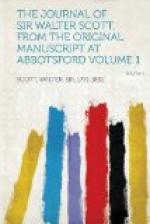[287] Painted for Lord Montagu in 1822.—See Life, vol. vii. p. 13.
Raeburn apparently executed two “half lengths” of Scott almost identical at this time, giving Lord Montagu his choice. The picture chosen remained at Ditton, near Windsor, until 1845, when at Lord Montagu’s death it became the property of his son-in-law, the Earl of Home, and it is now (1889) at the Hirsel, Coldstream. The engraving referred to was made from the replica, which remained in the artist’s possession, by Mr. Walker, and published in 1826. Sir Henry Raeburn died in July 1823, and I do not know what became of the original, which may be identified by an official chain round the neck, not introduced in the Montagu picture.
[288] Song of The Hunting of the Hare.—J.G.L.
[289] This entry reminds one of Hannah More’s account of Mrs. Garrick’s conduct after her husband’s funeral. “She told me,” says Mrs. More, “that she prayed with great composure, then went and kissed the dear bed, and got into it with a sad pleasure.”—See Memoirs of Mrs. More, vol. i. p. 135.—J.G.L.
[290] Campbell’s Turkish Lady, slightly altered. The poet was then editor of the New Monthly Magazine, but he soon gave it up.—J.G.L.
[291] Viz.: the first series of Chronicles of the Canongate, which was published in 1827. The title originally proposed was The Canongate Miscellany or Traditions of the Sanctuary.
Woodstock had just been launched under the following title:—Woodstock, or the Cavalier; a Tale of the Year Sixteen Hundred and Fifty-one, by the author of Waverley, Tales of the Crusaders, etc. “He was a very perfect gentle knight” (Chaucer). Edinburgh: Printed for Archibald Constable and Co., Edinburgh; and Longman, Rees, Orme, Brown, and Green, London, 1826. (At the end) Edinburgh: Printed by James Ballantyne and Co. 3 vols. post 8vo.




